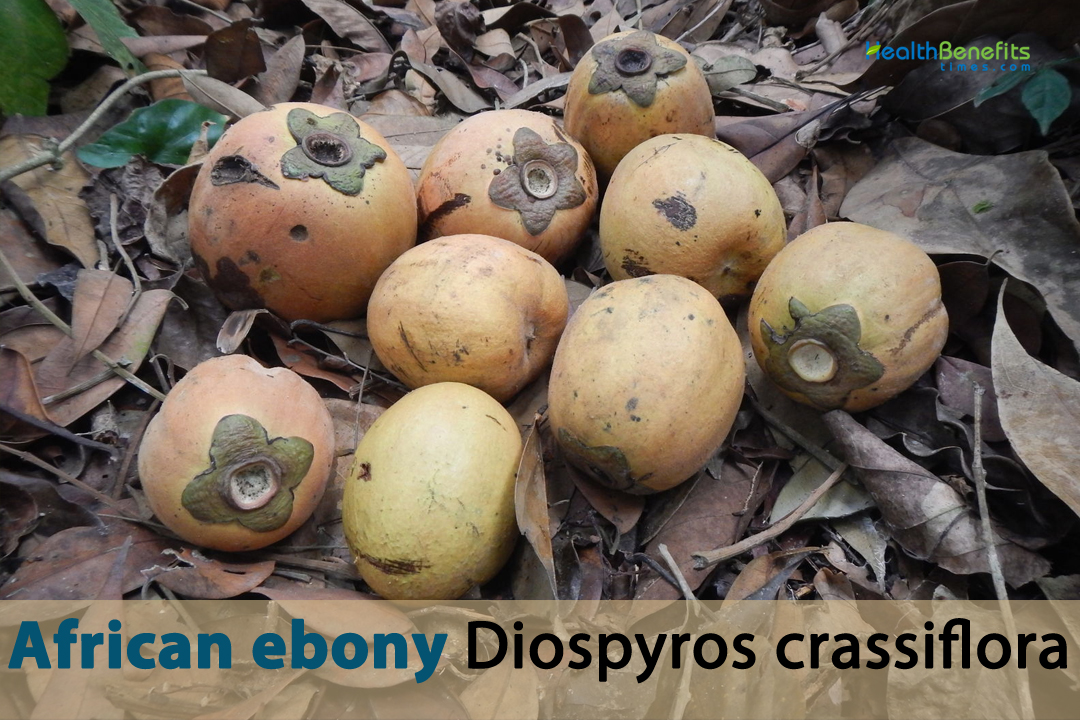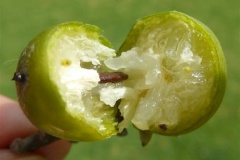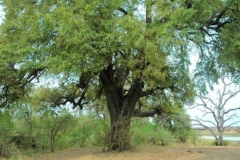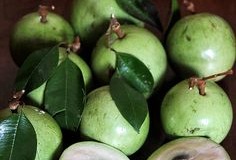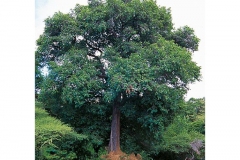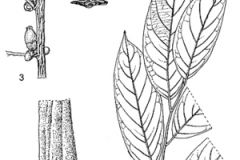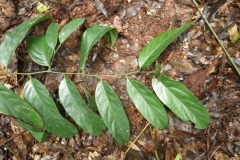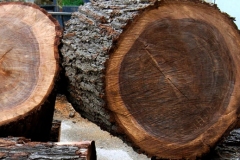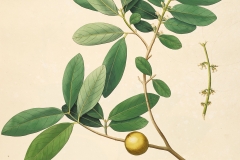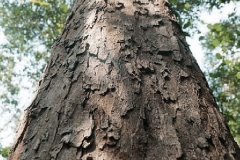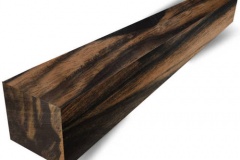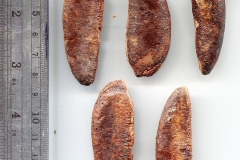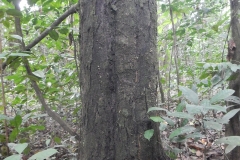The name Diospyros crassiflora comes from the Greek words “dios” which means “divine” or “of Zeus” and “pyros” which means “grain” or “wheat.” The name “Diospyros” comes from two Greek words that mean “sweet fruit.” This is a reference to the fact that some Diospyros species are thought to have sweet fruit. The name “crassiflora” comes from Latin, where the word “crassus” means “thick” or “dense,” and “flora” means “flower.” The name “crassiflora” comes from the fact that the flowers of Diospyros crassiflora are thick or swollen. The origin of Diospyros crassiflora shows that people thought the fruit was divine or sweet and that the flowers were thick or fleshy. These names come from things about the plant, like the fact that its fruit can be eaten and the way its flowers look.
African Ebony Facts
| African ebony Quick Facts | |
|---|---|
| Name: | African ebony |
| Scientific Name: | Diospyros crassiflora |
| Origin | Western Africa |
| Colors | Starting green and transitioning to a dark purple or black when fully ripe |
| Shapes | Ellipsoid to obovoid berry measuring around 2 to 4 centimeters (0.8 to 1.6 inches) in diameter |
| Health benefits | Beneficial for ovarian problems, purulent ophthalmia, treat yaws, stomachaches, diarrhea, coughs, bronchitis, heal wounds |
| Name | African ebony |
|---|---|
| Scientific Name | Diospyros crassiflora |
| Native | Western Africa. It is named after the West African state of Gabon, though it also occurs in Cameroon, Central African Republic, Republic of the Congo, Democratic Republic of the Congo, Equatorial Guinea and Nigeria |
| Common Names | Senegal black ebony, Sierra Leone ebony, Mozambique blackwood, Central African ebony, Ivory Coast blackwood, Malawian ebony, Gaboon wood, West African blackwood, Nigerian black ebony, Cameroon ebony, Equatorial ebony, Ugandan ebony, Benin black ebony, Mozambique ebony, Zebrawood, African ebony plum, Gabonese ebony, Ethiopian ebony, Tanzanian ebony, Gabon plum, Ghana ebony |
| Name in Other Languages | Acehnese: Eboni Afrika Afrikaans: Afrikaanse ebbenhout Albanian: Ahu eziak Amharic: Aferikawi amr’t (አፍሪካዊ አምርት) Arabic: Al-Abnus al-Afriqi (الأبنوس الأفريقي), kharmal samik al’azhar (خرمال سميك الأزهار) Armenian: Afrikakan abinos (Աֆրիկական աբինոս) Assamese: Afrikan Eboni (আফ্রিকান এবনি) Azerbaijani: Afrika ebenov ağacı Basque: Afrikako ebanoa Belarusian: Afrykanski ebenavy les (Афрыканскі эбенавы лес) Bengali: Aphrikāna aibhori (আফ্রিকান আইভরি), Aphrikān iban (আফ্রিকান ইবন), Kalo Sagban (কালো সাগবান), Afrikan Iboni (আফ্রিকান ইবনি) Bodo: Afrikan Eboni (আফ্রিকান এবনি) Bosnian: Afrička ebanovina Bulgarian: Afrikanski ebenovo darvo (Африкански ебеново дърво) Burmese: Aphrika aleing (အာဖရိက အလင်း) Catalan: Èbano africà Chhattisgarhi: Afrikan Ibeni (आफ्रिकन ईबनी) Chichewa: Nthambo ya Africa Chinese: Fēizhōu wūmù (非洲乌木), Fei zhou shi, Hòu bàn wūmù (厚瓣乌木) Coptic: Ebnos n’koutas (ⲉⲃⲛⲟⲥ ⲛ̀ⲕⲟⲩⲧⲁⲥ) Corsican: Ébanu affricanu Croatian: Afrički ebenovac Czech: Africký eben Danish: Afrikansk ibenholt Dari: Otm alghab (عتم الغاب) Dogri: Afriki Ebony (अफ्रीकी एबनी) Dutch: Afrikaans ebbenhout Dzongkha: Ae ben i bon (ཨེ་བེན་ཨི་བོ་ན།) English: Benin ebony, Ebony, African ebony, African persimmon Estonian: Aafrika eebenipuu Fijian: Uto ivoni ni Afirika Filipino: Ebano ng Aprika Finnish: Afrikkalainen eebenpuu, Gabonineebenpuu French: Ébène africaine, Ebénier véritable du Gabon, Evila, Mevini, Ébène d’Afrique, Ébène du Gabon, Ébène noir Frisian: Afrikaanske ebenhout Galician: Ébano africano Georgian: Aprikuli ebeni (აფრიკული ებენი) German: Afrikanisches Ebenholz, Madagaskar Ebenholz, afrikanischer Ebenholzbaum Greek: Afrikanikí Évenos (Αφρικανική Έβενος) Gujarati: Āphr̥ikan ā’ivarī (આફ્રિકન આઇવરી), Afrikan Iboni (આફ્રિકન ઇબોની), Kāḷō Sagavāna (કાળો સગવાન) Haitian Creole: Ebene afriken Haryanvi: Afriki Ibōnī (अफ्रीकी इबोनी) Hawaiian: ʻĒpano Apelika Hebrew: Even Afrikait (אבן אפריקאית) Hindi: Aphrīkī ēbanī (अफ्रीकी एबनी), Kala Sagwan (काला सागवान) Hungarian: Afrikai ebenfa Icelandic: Afrískt ebenholt Igbo: Mkpụrụobi Afụrịka Indonesian: Eboni Afrika Inuktitut: Imigisiak (ᐃᒥᒋᓱᐊᖅ) Irish: Éabha Afracach Italian: Ebano africano Japanese: Afurika kokutan (アフリカ黒檀), Diosupirosu atoropurupurea, Diosupirosu karasifurora (ディオスピュロス・クラスィフロラ) Javanese: Eboni Afrika Kannada: Āphrikā īban (ಆಫ್ರಿಕಾ ಈಬನ್), Afrikaada Eebani (ಆಫ್ರಿಕಾದ ಈಬನಿ), Karubēru (ಕರುಬೇರು) Kashmiri: Afriki Ebony (अफ्रीकी एबनी) Konkani: Afrikan Iban (आफ्रिकन ईबन) Kazakh: Afrika eben ülkesi (Африка эбен үлкесі), Afrikalıq eben ağaşı (Африкалық ебен ағашы) Khmer: Preng a’frika (ប្រេងអាហ្វ្រិក) Kinyarwanda: Umutobe w’Abafurika Konkani: Afrikan Eboni (आफ्रिकन एबोनी) Korean: Apeurika geom-eun namu (아프리카 검은 나무) Kumaoni: Afriki Ibōnī (अफ्रिकी इबोनी) Kurdish: Ebûnûsê Afrîkî, Afrîkî Ebûnûs Kyrgyz: Afrikalık eben aňyzy (Африкалык эбен аңызы) Lao: Kān chat kāt yānī (ການຈັດກາດຢານີ) Latvian: Āfrikas ebenholts Lithuanian: Afrikos ebenas Luxembourgish: Afrikanesch Ébenhuelz Macedonian: Afrikansko ebenovo drvo (Африканско ебеново дрво) Magahi: Afrikan Ibōnī (आफ्रिकन इबोनी) Maithili: Afrikan Ivoni (आफ्रिकन इवोनि) Malagasy: Eben’ny Afrika Malay: Kayu cendana Afrika Malayalam: Āphrikkan ībanī (ആഫ്രിക്കൻ ഈബനീ), Karuppan Vruksham (കറുപ്പൻ വൃക്ഷം), Aafrikkan Eebani (ആഫ്രിക്കൻ ഈബനി) Maltese: Abuż tal-Afrika, Abjad tal-Afrika Manipuri: Afrikan Eboni (আফ্রিকান এবনি) Maori: Ēpene Āwhiriki Marathi: Āphrikana ībana (आफ्रिकन ईबन), Kala Moha (काळा मोह) Marshallese: Kwojbar kōṃṃane Mongolian: Afrikijn eben (Африкийн эбен) Nepali: Aphrikālī ēbhānī (अफ्रिकाली एभनी) Ndebele: Umnquma waseAfrika Norwegian: Afrikansk ibenholt Odia: Afrikan Iboni (ଆଫ୍ରିକାନ ଇବନି), Kala Saguan (କଳା ଶଗୁଆନ) Papiamento: Ebano di Afrika Pashto: Afriqayi līṣad (افریقايي لیږد), Afriqayi līṣad (افریقايي لیږد) Persian: Otm alghab (عتم الغاب) Polish: Afrykańska heban Portuguese: Ébano africano, Ébano, das Antilhas Punjabi: Āphrīkī ivanī (ਆਫਰੀਕੀ ਇਵਨੀ), Kālā Sāgavāna (ਕਾਲਾ ਸਾਗਵਾਨ), Afriki Eboni (ਅਫਰੀਕੀ ਈਬੋਨੀ) Quechua: Aprika yana Rajasthani: Afriki Ebony (अफ्रीकी एबनी) Romanian: Lemn de eben african Russian: Afrikanskoye chërnoye derevo (Африканское чёрное дерево) Samoan: ʻEbano o Afelika Sanskrit: Afriki Ebony (अफ्रिकी एबनी) Santali: Afrikan Eboni (আফ্রিকান এবনি) Scots Gaelic: Ebain Afragaich Serbian: Afrički ebon (Афрички ебон) Sesotho: Moware oa Afrika Sikkimese: Afriki Ibōnī (अफ्रीकी इबोनी) Sindhi: Afriki Eebani (افريڪي ايباني) Sinhala: Aphrika ībani (අෆ්රිකා ඊබනි) Slovak: Africký ebenovník Slovenian: Afriški ebenov les Somali: Dhuxul Afrikaan ah Spanish: Ébano africano, Ébano Swahili: Mpingo wa Afrika Swedish: Afrikansk ebenholts, Flammig ebenholts Tajik: Darafti ebenhoi afriqoī (Дарафти эбенҳои африқоӣ) Tamil: Āppirikkap parumpu (ஆப்பிரிக்கப் பரும்பு), Karuppu Mantai Kilangu (கருப்பு மன்தைக்கிழங்கு), Aabrikka Eeboni (ஆபிரிக்க ஈபோனி) Tatar: Afrika eben (Африка эбен) Telugu: Āphrikān ībanī (ఆఫ్రికన్ ఈబనీ), Nalla Mantega (నల్ల మంతేగ), Afrikan Eboni (ఆఫ్రికన్ ఎబనీ) Thai: Mâi sạk Ēphrikā (ไม้สักแอฟริกา) Tibetan: Ae ben i bo (ཨེ་བེན་ཨི་བོ།) Tongan: ʻEbani ʻAfelika Tulu: Afrikan Eebani (ಆಫ್ರಿಕನ್ ಈಬನಿ) Turkish: Afrika ebenuağacı Turkmen: Afrika eben agajy Uighur: Afrigha siyasi (ئافرىقا سياھىسى) Ukrainian: Afrikans’ka ebenova derevyna (Африканська ебенова деревина) Urdu: Afriqi abnus (افریقی ابنوس), Kala Sagwan (کالا ساگوان) Uzbek: Afrika ebeni Venda: Mpfufu wa Afrika Vietnamese: Gỗ đen châu Phi Welsh: Eben Affricanaidd Wolof: Gen d’Afrika Xhosa: Umgcibelo waseAfrika Yiddish: Afrīkanisher ebnhoyts (אַפֿריקאַנישער עבנהויץ) Yoruba: Eti ebony Afrika Zulu: Umnquma waseAfrika |
| Plant Growth Habit | Slow-glowing, medium-sized, lowland-rainforest tree |
| Growing Climates | Lowland semi-deciduous, evergreen rain forest, semi-deciduous forest near the coast or also in islands of evergreen rainforest within semi-deciduous Sterticulaceae or Ulmaceae forest |
| Soil | Grows well in deep, well-draining soils with a pH range of 5.5 to 7.5. It can tolerate a variety of soil types, including loamy, sandy, or clay soils. However, it prefers fertile soils with good organic matter content. Proper soil drainage is crucial to prevent waterlogging |
| Plant Size | From 15 to 30 meters (50 to 100 feet). However, exceptional individuals or trees in optimal conditions may grow taller, potentially exceeding 30 meters (100 feet). The cylindrical or fluted bole can be free of branches for up to 15 metres and up to 120 cm in diameter |
| Root | Strong taproot that grows straight down |
| Bark | Smooth and greenish-gray, but as the tree matures, it becomes rougher and darker in color |
| Leaf | Simple, often oval or elliptical about 5 and 15 cm (about 2 to 6 inches) long and 3 to 8 cm (about 1 to 3 inches) wide |
| Flowering season | April and June |
| Flower | White or cream-colored usually between 0.4-0.8 inches, or 1 to 2 centimeters |
| Fruit Shape & Size | Ellipsoid to obovoid berry measuring around 2 to 4 centimeters (0.8 to 1.6 inches) in diameter |
| Fruit Color | Starting green and transitioning to a dark purple or black when fully ripe |
| Seed | Small, brownish-black in color, and typically measure around 1 to 2 centimeters (0.4 to 0.8 inches) in diameter |
| Varieties |
|
| Taste | Mild, pleasant scent |
| Plant Parts Used | Bark, leaves, root |
| Propagation | By Seed, stem cutting, grafting, air layering |
| Lifespan | Can live for several decades, with some individuals reaching ages of 100 years or more under favorable conditions |
| Season | July and November |
| Major Nutrition |
|
| Health benefits |
|
Plant Description
African ebony is a slow-glow tree that grows from 15 to 30 meters (50 to 100 feet) tall in lowland rainforests. But some people or trees can grow taller than 30 meters (100 feet), and this is possible in the best situations. The cylinder or fluted bole can be up to 15 meters long and up to 120 cm in diameter without any branches. The bole doesn’t have any supports. The heartwood of this tree is the real ebony of trade, and Benin, East Cameroon, and Gabon have been exporting it for a long time. However, Gabon and East Cameroon may now be over-exploiting it. The plant grows in lowland semi-deciduous, evergreen rain forest, semi-deciduous forest near the coast, and patches of evergreen rainforest in semi-deciduous Sterticulaceae or Ulmaceae forest.
African ebony grows well in soils that are deep, have good drainage, and have a pH between 5.5 and 7.5. It can grow in a wide range of soils, including sandy, loamy, and clay. But it likes grounds that are rich in organic matter and are fertile. To avoid waterlogging, the dirt must drain well. This is one of 33 species that are known to be good for making Hongmu (red wood), which is used to make high-quality Chinese furniture in the style of the Ming and Quing dynasties. This makes it a very valuable wood. Almost all of this species’ big trees have been cut down for their ebony wood, except maybe in the most remote parts of its range. The plant is on the IUCN Red List of Threatened Species, which means it is in danger of going extinct. In some African tribes, different things are done with the fruit of the African ebony tree. It can be eaten, or the pulp can be used in traditional medicine because it is thought to be good for your health.
Appropriate growing environment for African ebony
African ebony thrives in specific growing conditions that provide the necessary climate and habitat for its optimal growth. Here are the key elements of an appropriate growing environment for African ebony:
- Climate: African ebony comes from the warmer parts of West and Central Africa. It can only grow in places that are warm and damp. Temperatures between 20 and 30 degrees Celsius (68 and 86 degrees Fahrenheit) are best for its growth. It likes to live in places that get 60 to 100 inches (1.5 to 2.5 meters) of rain a year all year long.
- Sunlight: In general, African ebony grows and develops best when it gets full sun. It needs to be in bright sunlight for most of the day. Getting enough sunshine helps the tree grow strongly and reach its full height and canopy spread.
- Soil: African ebony grows well in soils that are deep, have good drainage, and have a pH between 5.5 and 7.5. It can grow in a wide range of soils, including sandy, loamy, and clay. But it likes grounds that are rich in organic matter and are fertile. African ebony can get root rot if the soil stays too wet for too long. This can be avoided by making sure the soil drains well.
- Water: Even though African ebony is known for being able to handle drought, it needs regular and steady water when it is young. Young plants need enough water to get started and help their roots grow in a healthy way. Once it’s grown, the tree can survive times when it doesn’t rain much. But long periods of drought can hurt its growth and ability to stay alive.
- Protection from Frost and Cold: Frost and cold weather can hurt African ebony. It grows best in places where it doesn’t freeze, because temps below 5 degrees Celsius (41 degrees Fahrenheit) can hurt or kill the tree. If you live in an area where frost happens sometimes, you need to protect your plants from the cold by giving them shade or covering them.
- Wind Protection: African ebony grows best when it is protected from strong winds, especially when it is young. Windbreaks, like surrounding plants or man-made walls, can help create a protected area for young plants, lowering the risk of wind harm.
Roots
The seed of an African ebony tree grows into a strong taproot that grows straight down. The main support of the tree is the taproot, which keeps it steady. It is also a key part of the tree’s ability to get water and nutrients from lower layers of soil, which makes the tree stronger during dry times. A lot of side roots come out of the base of the tree and grow in different directions horizontally. These side roots make up most of the tree’s root system and help the tree stay stable and take in nutrients. They grow sideways to cover more ground and help the tree get the most water and minerals from the dirt. The roots of the African ebony tree have tiny, long structures called root hairs all over them.
These tiny bumps increase the surface area of the roots by a lot, making it easier for them to get water and nutrients from the dirt. The tree gets most of the nutrients it needs from the soil through its root hairs. The root cap is a protective layer at the end of each root, including the taproot and lateral roots. The root cap helps the plant move through the dirt and keeps the delicate growing area behind it from getting damaged. It also makes mucilage, which is a gel-like substance that helps it get into the earth and absorb nutrients.
Stem
Bark is the outermost layer of the stem. It covers the tissues beneath it. The bark of African ebony is rough and thick, and it is dark brown to black in color. As the tree gets older, it may get deep cracks and wrinkles. Under the bark is the cork cambium, which is a thin layer that makes cork cells. The cork cambium keeps making new cork cells that move toward the outside, which helps the bark grow. Between the cork cambium and the vascular cambium is a layer called the phloem. It has sieve tubes, partner cells, fibers, and cells in the parenchyma. Sugars and other organic substances made in the leaves during photosynthesis are moved to other parts of the tree by the phloem.
A layer of meristematic tissue called the vascular cambium makes new cells for both the xylem and the phloem. It is what makes secondary growth happen, which makes the stem wider. The cambium around the xylem looks like a ring. The xylem is the muscle in the stem that moves water and minerals around. The xylem of African ebony is made up of tubes, fibers, and tissue cells. Vessels are long, tube-like structures that connect to make a network that moves water efficiently. Like most trees, African ebony grows in rings. Each ring shows one year of growth and is made up of xylem cells that are different sizes and densities. In cross-sections of the stem, you can see these rings, which can tell you how old the tree is and how it grew.
Bark
The bark is rough and usually looks deeply cracked and ridged. As the tree gets older, the bark gets rougher and more noticeable. The bark can be different colors, but it’s usually dark brown to black. People often think that the dark color comes from the rich melanin in the heartwood of the tree. As the tree gets older, the bark gets deep cracks and wrinkles. The bark looks rough and unique because of these natural shapes. The cracks and ridges can be irregular and make designs on the bark that are hard to describe.
Under the bark’s top layer is a layer of cork called the cork cambium. As the tree grows, it is the cork cambium’s job to make new cork cells, which slowly replace the older top bark layer. Lenticels are small holes or bumps on the bark that stick up. These holes let gases move between the inside of the tree and the air around it, making it easier for the tree to breathe. The bark protects the inner parts of the tree from physical damage, disease-causing organisms, and environmental factors. It keeps the tree from losing too much water and keeps the temperature from changing too much.
Leaves
Along the stem, the leaves are grouped in pairs. This means that each leaf grows from a different place on the plant, going from side to side. The leaves are simple, which means that there is only one leaf blade (lamina) connected to a stalk. The form of a leaf blade is often oval or elliptical. Sizes can be different, but they are usually big. The normal size of a leaf is between 5 and 15 centimeters (about 2 to 6 inches) long and 3 to 8 centimeters (about 1 to 3 inches) wide. Smooth and shiny, the leaf’s surface gives it a shiny look. The top of the leaf is usually a dark green color, while the bottom may be a little lighter.
Leaves show prominent veins. The veins are pinnate, which means that they branch out from the midrib (the main vein) in a feather-like design toward the edges of the leaf blade. During the tree’s growth stage, the leaves can change color. Young leaves may have a reddish or brown color, but as they get older, they change to a deep, dark green. This helps the plant grow in a way that is open and spreading, so that the leaves can get enough sunshine for photosynthesis to work well. During photosynthesis, the leaves are very important because they take in light and turn it into energy. They also help gas exchange by letting carbon dioxide move into the leaves and oxygen move out.
Flower
The width of a flower is usually between 0.4 and 0.8 inches, or 1 to 2 centimeters. Most of the time, they are white or cream-colored. In their native places, African ebony trees tend to grow during the rainy season. The exact time can change based on the weather in the area, but flowers usually bloom in the spring or early summer. The flowers are bisexual, which means they have both male and female parts that help them reproduce. Each flower has a calyx with five lobes, a corolla that looks like a tube, and several petals.
The flowers of the African ebony tree often have a nice, sweet smell. Pollinators like bees, butterflies, and other animals can be drawn to this smell. Most flowers are pollinated by insects, which are drawn to the scent and juice of the flower. These insects help move pollen from one flower to another, which leads to fertilization and then the growth of food. Even though the flowers aren’t very pretty, they are very important to the tree’s ability to reproduce. They bring in pollinators and start the process of making fruits, which hold the tree’s seeds and help them spread and grow.
Fruit
Fruit is a smooth-skinned, round berry. It usually has a width of 2 to 4 centimeters (0.8 to 1.6 inches). The color of the fruit changes as it ripens. It starts out green and ends up dark purple or black. There are a few small, brownish-black seeds inside the fleshy body of the fruit. The pulp is sweet and juicy, and it goes all the way around the seeds. The ripe fruit can be eaten. It tastes sweet, and both people and different kinds of animals like to eat the pulp.
Fruits usually get ripe during the wet season, which varies from place to place. As the fruit ripens, it changes from green to dark purple or black. This shows that it is ready to eat. There are a lot of carbs, vitamins, and minerals in fruit pulp. It gives animals food and can also be eaten by people.
Seeds
The seeds are small, brownish-black, and usually measure between 0.4 and 0.8 inches (or 1 to 2 centimeters) in diameter. The baby inside is protected by a hard, woody shell. The round berry that is the fruit grows seeds inside of it. In the mushy center of the fruit are several seeds. Most seeds get from one place to another because of animals. Birds and animals eat the ripe fruits and then poop out the seeds in different places. This helps the seeds spread naturally.
African ebony seeds may be able to grow into new trees for a long time. When seeds are kept in the right way, they can keep their ability to grow for several years. This makes it possible for plants to grow back. Some African tribes may have cultural or traditional uses for the seeds of African ebony. They can be used in arts and crafts, jewelry, and other creative works.
Varieties of African ebony
Diospyros crassiflora is typically considered as a single species without widely recognized or formally established varieties. These variations are not officially recognized as distinct varieties but may help understand the diversity within Diospyros crassiflora:
- Gaboon Ebony (Diospyros crassiflora): Gaboon ebony is the most well-known and important type of African ebony in terms of business. It is very valuable because of its dark color, fine texture, and even look. Gaboon ebony is used to make furniture, musical instruments, and decorative items that are of good quality.
- Nigerian Ebony (Diospyros spp.): Nigerian ebony refers to species or types of ebony that are found in Nigeria and the areas around it. It can include different Diospyros species or types with similar traits to African ebony, such as dark wood and a fine texture. Nigerian ebony is also used to make furniture and other things.
- Cameroon Ebony (Diospyros spp.): Cameroon ebony includes all kinds of ebony from Cameroon and nearby countries. Like Nigerian ebony, it can include more than one species or type of Diospyros. Cameroon ebony is used in many craft projects because of its dark, rich color.
- Mozambique Ebony (Diospyros spp.): Mozambique ebony refers to ebony species or varieties found in Mozambique and adjacent areas. It can include different types of Diospyros trees that look like ebony. Mozambique ebony is used to make high-end furniture, flooring, and musical instruments. It is prized for its dark black color.
- Ivory Coast Ebony (Diospyros spp.): Ivory Coast ebony is any species or type of ebony that grows in Ivory Coast (Côte d’Ivoire) or close by. It includes different types of Diospyros trees that look like ebony. Ivory Coast ebony is known for its dark color and is used to make fine furniture, cabinets, and decorative items.
Health benefits of African ebony
African ebony, scientifically known as Diospyros crassiflora, is a tree that offers several potential health benefits. While traditional medicinal practices have utilized various parts of the tree, including the bark, leaves, and fruits, it’s important to note that scientific research on the specific health benefits of African ebony is limited. Here is some of the potential health benefits associated with African ebony:
1. Digestive Health
African ebony has been used for a long time to help with stomachaches, diarrhea, and sickness. Some common ways to treat these conditions are to use the bark or fruit extracts. But more study is needed to figure out how it works and how well it works.
2. Anti-inflammatory Effects
African ebony has been used in the past in ways that suggest it might help with pain and inflammation. Inflammation is a normal reaction of the body, but if it lasts too long, it can lead to a number of diseases. Even though compounds in African ebony may have anti-inflammatory effects, more study is needed to figure out how they work and prove these claims.
3. Respiratory Support
African ebony has been used in the past to treat problems with the lungs. It has been used to ease the signs of breathing problems like coughs and bronchitis. But science studies are needed to prove these claims and figure out how these possible effects might work.
4. Antimicrobial Properties
It has been said that African ebony has antimicrobial qualities. In lab tests, extracts of the bark and leaves showed that they could kill certain bacteria and fungus. These properties suggest that they might be able to treat microbial infections, but more study is needed to find out how well and safely they work.
5. Antioxidant Activity
There are chemicals in African ebony that may have antioxidant qualities. Antioxidants help the body get rid of dangerous free radicals, which could reduce oxidative stress and damage to cells. This could affect the health of the population as a whole and could help stop chronic diseases. But more research needs to be done on the individual antioxidant compounds and how they work.
6. Wound Healing
In the past, African ebony was used to help heal wounds. People think that the trees bark and leaves have qualities that help skin grow back and speed up the healing process. However, scientific studies are needed to find out how this possible benefit works and how well it works.
7. Anti-Diabetic Effects
Some of the ways African ebony has been used in the past suggest that it might help people with diabetes. It has been used to control blood sugar levels, but there isn’t much scientific evidence to back this up. To figure out if African ebony could help with diabetes, more research needs to be done.
8. Anti-Cancer Potential
Preliminary tests have shown that some of the chemicals in African ebony may help fight cancer. In lab tests, these compounds have stopped the spread of cancer cells, which is a good sign. But more study is needed to figure out the exact mechanisms and how they might be used to treat cancer.
9. Cardiovascular Health
In the past, African ebony was used to help keep the heart healthy. It is thought to have qualities that could help lower blood pressure and lower the risk of heart problems. But there isn’t any solid evidence to back up these claims right now.
10. Anti-Malarial Properties
Some study suggests that African ebony may be able to fight malaria. In lab tests, some compounds that were taken from the plant were shown to stop malaria parasites from spreading. But more study is needed to find out if African ebony is safe and if it works to treat malaria.
11. Analgesic (Pain-Relieving) Effects
African ebony has been used to treat pain for a long time. People sometimes rub the bark and leaves on their skin or drink a beverage made from them to relieve pain from different conditions. However, scientific studies are needed to figure out how and why African ebony works as a painkiller.
12. Anti-Ulcer Properties
In the past, African ebony was used to help ulcers feel better. Some chemicals in the plant, like tannins, have shown promise in early studies as possible ulcer treatments. But more study is needed to find out if African ebony works and is safe for treating ulcers.
13. Antipyretic Effects
In the past, African ebony was used to bring down fever. It is thought to have chemicals that can help cool the body down. But there isn’t any scientific evidence to back up this claim, and you should always talk to a doctor about how to treat a fever.
14. Liver Protection
African ebony has been used in the past, which suggests that it could help keep the liver healthy. It has been used to protect the liver and help it do its job of getting rid of toxins. But science studies are needed to find out how these things work and prove that they are true.
15. Antiviral Activity
Researchers have looked into whether African ebony can kill viruses. In the lab, some tests have shown that it might stop certain viruses from spreading. But more study is needed to find out how African ebony can be used and how well it works for viral infections.
16. Anti-Hypertensive Effects
In the past, African ebony was used to treat hypertension (high blood pressure). There are some chemicals in the plant that may help lower blood pressure. Still, more scientific study needs to be done to figure out the exact mechanisms and possible therapeutic uses.
17. Anti-Infective Properties
In traditional medicine, African ebony has been used to treat a number of illnesses. Even though there isn’t much scientific proof to back up these claims, the plant’s compounds may have antibacterial and antifungal effects. More study is needed to find out if African ebony is safe and effective for treating infections.
18. Anti-Allergic Effects
Some of the ways African ebony has been used in the past suggest that it might help with allergies. It has been used to help relieve allergy symptoms like sneezing and itching. But scientific studies are needed to look into the possible processes and how well they work to treat allergies.
19. Skin Health
In the past, African ebony was used to keep the face healthy. It is thought to have properties that can nourish and moisturize the skin, which could make the skin look and feel better generally. But there isn’t a lot of scientific study on how African ebony affects the skin.
20. Aphrodisiac Properties
African ebony has been used as an aphrodisiac to increase sexual desire and success in traditional medicine. But there isn’t any scientific evidence to back up this claim, and more study is needed to find out what effects it might have on sexual health.
21. Mental Health Support
African ebony has been used for a long time because it may help calm and improve your mood. It is thought to help lower anxiety and stress and make people feel more relaxed. Few scientific studies have been done on how it affects mental health, though.
22. Nutritional Value
The leaves of the African ebony tree are known for how healthy they are. They have a lot of vitamins and minerals, like vitamin C, potassium, and calcium. Adding African ebony fruits to a healthy, well-balanced diet can help with general nutrition.
Different uses of African ebony
African ebony has a wide range of uses due to its unique properties, durability, and distinctive appearance. Here are different applications and uses of African ebony:
- Woodworking: African ebony is a very valuable wood for making furniture and other things. It is known for being hard and thick, with a fine, deep black or dark brown color. It is used to make high-quality furniture, cabinets, floors, and decorative items like sculptures, turned bowls, and veneers.
- Musical Instruments: African ebony is a popular wood for making musical instruments because it has good sound qualities. It is often used to make guitar fingerboards, piano keys, clarinet bodies, violin fingerboards, and other parts of musical instruments that need to be strong, stable, and have a good sound.
- Decorative Objects: African ebony is often used for decoration because of its dark color and smooth finish. It is carved or shaped into statues, masks, figurines, and other decorative items with a lot of detail. African ebony is striking to look at because of its dark color and fine grain. It is highly valued for its beauty.
- Luxury Items and Jewelry: African ebony is sometimes used to make high-end jewelry and other luxury things. It is made into beautiful things like watches, pens, buttons, and parts for high-quality jewelry. African ebony is great for making fine, long-lasting ornaments because it is strong and naturally beautiful.
- Handles and Grips: Because it is strong and durable, African ebony can be used to make handles and grips for tools, cutlery, and other items. Its hardness and resistance to wear make it a good choice for things like knife handles, walking sticks, and sports tools that need to be held securely and comfortably.
- Turning and Carving: Wood turners and carvers like African ebony because it is smooth and easy to work with. It can be shaped, turned, and carved into intricate patterns, decorative accents, and useful things like bowls, vases, and tools.
- Specialty Items: African ebony can be used to make luxury items like high-end pens, executive work sets, and luxury furniture that are made to order. Its scarcity, unique look, and high quality make it a popular choice for one-of-a-kind and custom-made items.
- Architectural Applications: African ebony is sometimes used in building projects, especially because it looks nice and is strong. It can be used to make doors, window frames, paneling, and special trim work. This gives both inside and outside areas a touch of elegance and sophistication.
- Inlay and Marquetry: African ebony is often used for carving and marquetry work because of how smooth it is and how dark it is. Thin pieces or strips of ebony are carefully placed into furniture, cabinets, and musical instruments to make designs, borders, and accents.
- Flooring: African ebony is very popular for flooring because it is hard and doesn’t wear down easily. It is used to make beautiful and long-lasting hardwood floors in both homes and businesses, giving interiors a touch of luxury.
- Sculpture Bases: African ebony is a good choice for carving bases because it is dense and stable. Its strength and weight make it a good base for statues and other works of art, making them stable and lasting.
- Knife Handles and Cutlery: African ebony is often used for knife handles, silverware, and other tools because it is hard and durable. Its natural oils and resistance to moisture help keep these tools in good shape and make them last longer.
- Luxury Packaging: African ebony is sometimes used to make high-end packaging, like boxes for expensive jewelry, watches, or other unique things. Its polished look and natural elegance add to the worth and presentation of the packaged goods.
- Specialty Turning and Craftsmanship: Wood turners and other craftspeople prize African ebony for its unique qualities. It is used to make things like pens, chess pieces, pool cues, and custom-made items that take a combination of skill and the unique qualities of African ebony.
- Cultural and Artistic Significance: African ebony is important to the culture and art of many African nations. It can be used to make traditional crafts, masks, items for ceremonies, and tribal art that show the region’s cultural heritage and artistic styles.
- Luxury Furniture: High-end luxury furniture is often made from African ebony, which is a very popular wood. Its dark color, fine texture, and strength make it a popular choice for making elegant and beautiful pieces of furniture, like dinner tables, chairs, cabinets, desks, and other pieces that have a timeless beauty.
- Executive Office Accessories: African ebony is often used to make things like desk sets, pen holders, paperweights, and business card holders for senior offices. Its high-end look adds a touch of sophistication to office areas and shows professionalism and good taste.
- Architectural Details: African ebony can be used to make architectural details and accents that make buildings and places look better. It can be used to make moldings, door frames, window trims, stair railings, and steps that look rich and elegant.
- Decorative Veneers: African ebony is very valuable because it can be cut into thin pieces. These veneers can be put on a variety of surfaces, like furniture, cabinets, wall panels, and decorating items. They give the overall design a touch of elegance and luxury.
- Museum and Exhibition Displays: African ebony is great for museum shows and exhibits because it is dark and stands out. It is used to make pedestals, plinths, and display cases to show off artifacts, statues, and other valuable items. This improves how they look and how they are presented.
- Jewelry Boxes and Chests: African ebony is often used to make jewelry boxes and chests because of its dark color and smooth feel. Its natural beauty and strength make it a luxurious and safe way to store jewelry and other valuable items.
- Fine Joinery and Cabinetry: African ebony is strong and stable, so it can be used to make fine furniture and cabinets. It is used to make joinery details, dovetail joints, and exact cabinetry parts that need to be strong, accurate, and made to last.
- Luxury Yacht Interiors: African ebony is sometimes used to decorate the inside of ships and boats with a high price tag. It can be used for walls, floors, accents, and furniture, giving these marine settings a sense of exclusivity and refinement.
Side effects of African ebony
African ebony is primarily known for its wood and is not typically consumed as a food or for medicinal purposes. As a result, there is limited information available regarding potential side effects specific to African ebony. However, it’s important to note the following general considerations:
- Allergic Reactions: African ebony dust or particles could cause allergic reactions in people who are sensitive to or allergic to wood dust or certain types of wood. This can cause things like skin irritation, breathing problems, and eye inflammation. When dealing with African ebony wood, it’s important to use the right safety gear and make sure there’s enough airflow.
- Safety Precautions: African ebony is a thick, hard wood that can be difficult to work with. For cutting, shaping, and finishing, you need special tools and skills. When you work with African ebony, be careful not to cut yourself on sharp tools or splinters.
- Sustainability Considerations: Concerns have been raised about African ebony because of how it is harvested and because trees are being cut down. To protect the species and its environment, it’s important to make sure that the African ebony you buy comes from sources that are sustainable and well-managed.
- Interaction with Medications: If African ebony or its products are used as medicine, they might not work well with other drugs. Before using African ebony in any form, you should talk to a doctor or a trained herbalist. This is especially important if you are taking medications or already have health problems. They can give advice about possible conflicts, side effects, or safety measures.
- Lack of Safety Information: Due to a lack of scientific study and documentation, there may not be enough information about how safe it is to eat or use African ebony as medicine. Before using African ebony for anything, it’s best to be careful and ask an expert for help.
- Risk of Contamination: There is a chance of pollution or adulteration when African ebony is used for anything, including medicine or food. Make sure the source of the African ebony is reliable and that quality control steps have been taken to reduce the risk of being exposed to impurities or contaminants.
- Cultural Practices and Traditions: Certain parts of the African ebony tree have been used as medicine in some traditional African tribes. These habits may be different and may have regional meanings. It’s important to respect and understand the cultural background of these practices, as well as be aware of any risks or side effects they might have.
- Personal Sensitivities: Some people may be allergic or sensitive to African ebony or its parts. If you have any kind of bad reaction, like an allergic reaction, skin rash, or breathing problems, stop using it and see a doctor.
- Wood Dust Inhalation: When working with African ebony wood, there is a chance of making wood dust. When you breathe in wood dust, it can irritate your lungs and cause symptoms like coughing, wheezing, or lack of breath. When working with African ebony wood, it’s important to wear the right safety gear, like a mask or respirator, and make sure there’s enough airflow so you don’t breathe in too much wood dust.
- Sensitization and Dermatitis: Some people may become allergic or sensitive to certain kinds of wood. If you touch African ebony wood directly, especially for a long time, it could cause skin irritations, contact dermatitis, or allergic responses. When working with African ebony wood, it is best to wear gloves and other protective clothing to keep your skin from coming in direct touch with the wood.
- Occupational Hazards: Workers like woodworkers and artists who handle or work with African ebony wood may be at risk of occupational hazards. Because African ebony wood is so dense, these can be caused by sharp tools, accidents while cutting or shaping the wood, or strains from lifting big things. To lessen these risks, proper safety steps, training, and the use of the right tools and equipment should be used.
- Environmental Considerations: Concerns have been raised about African ebony because of illegal cutting and harvesting methods that aren’t good for the environment. If the species are used in a way that isn’t healthy, it can hurt the environment and cause species to die out. To help protect the environment and support conservation efforts, it is important to get African ebony from sources that are handled in a sustainable way.
References:
https://www.itis.gov/servlet/SingleRpt/SingleRpt?search_topic=TSN&search_value=896218#null
https://pfaf.org/user/Plant.aspx?LatinName=Diospyros+crassiflora
https://www.cabidigitallibrary.org/doi/10.1079/cabicompendium.19546
http://www.theplantlist.org/tpl/record/kew-2769577
https://en.wikipedia.org/wiki/Diospyros_crassiflora
https://tropical.theferns.info/viewtropical.php?id=Diospyros+crassiflora
https://en.hortipedia.com/Diospyros_crassiflora
https://gd.eppo.int/taxon/DOSCF
http://uses.plantnet-project.org/en/Diospyros_crassiflora_(PROTA)
https://www.inaturalist.org/taxa/191530-Diospyros-crassiflora


